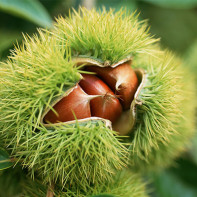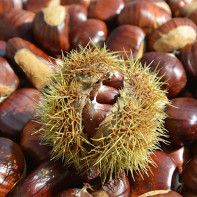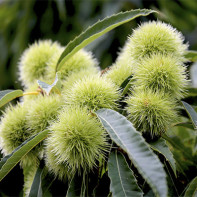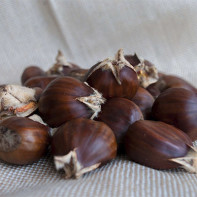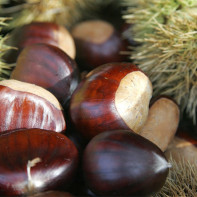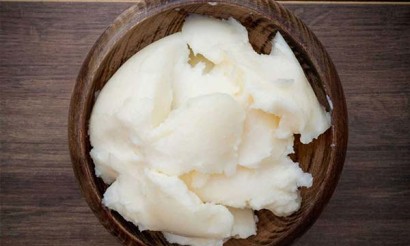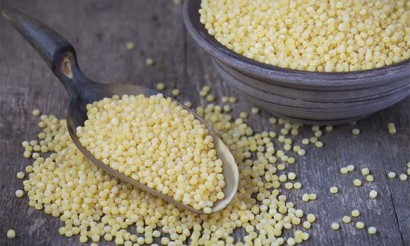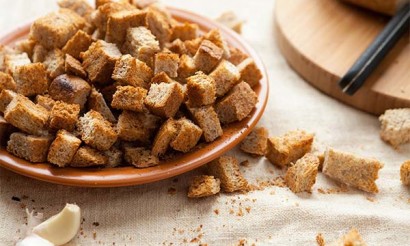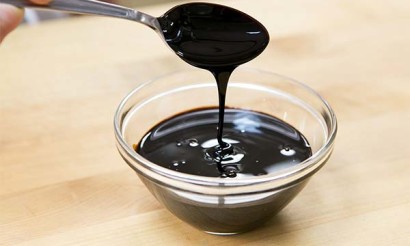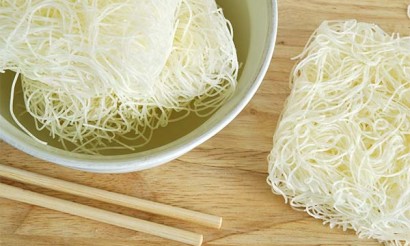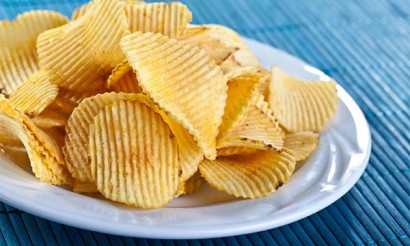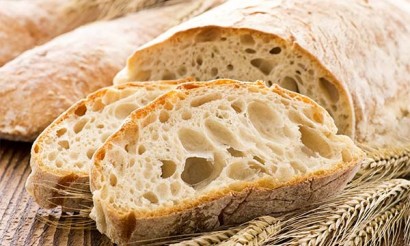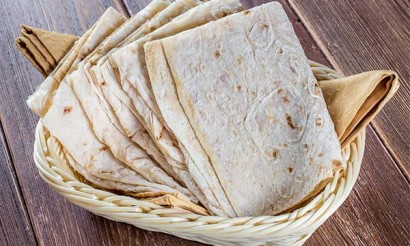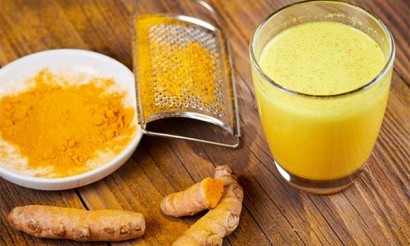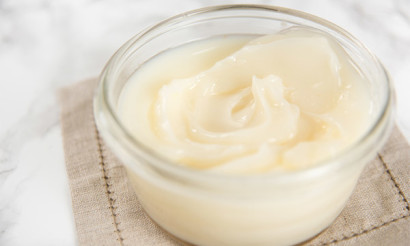Edible Chestnut: useful properties and recipes
Surprising and diverse flora of planet Earth. Millions of different plants - large and small, known and not so grow in almost every corner of the globe. And all of them are endowed with the ability to influence the human body. It turns out that many plants have the ability to heal people from various diseases, to help them improve their health and maintain their beauty and youth. These unique plants include edible or real chestnut, the strength and usefulness of which can have a beneficial effect on many systems of the human body.
- How it looks and where it grows
- Types
- How to tell the difference between the edible and the inedible chestnuts
- Composition and calories
- What is the usefulness of the edible chestnut?
- General benefits
- For Women
- For Men
- For Pregnancy
- For breastfeeding
- For children
- When losing weight
- Applied in folk medicine
- In varicose veins
- The cyclic pain in women
- In the treatment of thrombophlebitis
- In joint pain
- For gastritis
- For external use
- For normalization of cholesterol
- How to use in cosmetology
- For pore shrinkage and nourishing facial skin
- To preserve youth
- Anti acne mask
- Against hair loss and to activate hair growth
- Edible chestnut in cooking
- Hot Chestnut Snack
- Baked chestnut
- Soup
- Hazards and contraindications
- How to choose and store
- Is it possible to eat horse chestnut
- Interesting Facts
What it looks like and where it grows
The noble chestnut belongs to the Beech family. The height of these trees can reach up to 50 m. Its brownish-brown bark is quite strong and thick. Chestnut leaves resemble an elongated oval. They can be up to 25 cm long. Their color is usually dark green. There are denticles along the edges. The fruits themselves are placed in the so-called ivy, which has prickles on the outside and is fluffy on the inside. As a rule, one ivy can contain up to 3 nuts, but sometimes you can find 7 pieces. When ripening in October, the "box" splits into 4 or 2 (which is much rarer) parts. The fruits are brown in color, glossy, and the seeds are light brown with a yellowish, fleshy germ that contains quite a lot of starch.
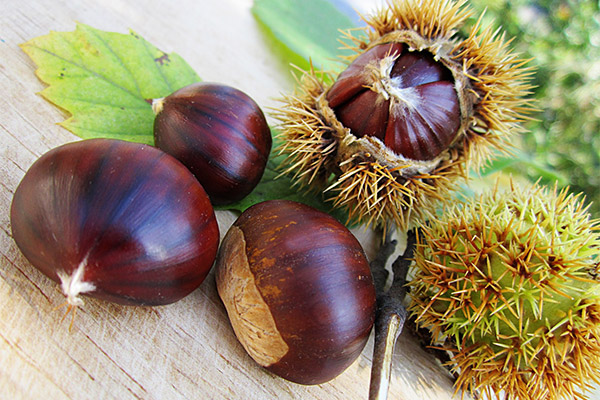
Chestnut has been known since the Cretaceous period. It prefers warm climates. Typical places for Chestnut are in the Mediterranean, in East Asia, in the United States near the Atlantic Ocean and in the southern regions of Russia, Ukraine and the Balkans.
The plant settles on shady mountain slopes, but it does not like dry or swampy soils.
Species
To date, the most popular, in addition to the real chestnut, are considered several species: Australian, red, horse, Guinea, Japanese, Chinese, smooth, forest and Indian.
- Australian. This species is also referred to as an indoor species, as one of the subspecies is actually grown for home decoration. It is only 3 m tall. It is grown in wide pots at a temperature of +18°C to +25°C. The other species is about 40 m tall and is found in Australia. It likes moisture and therefore chooses places near rivers. In spring, bright, red or orange flowers appear on the tree, to be replaced by 20-cm pods containing poisonous fruits - nuts.
- Red. This is a beautiful, evergreen, ornamental plant that reaches 25 m in height. The tree is capricious and loves fertilizer and moisture. During the flowering period, which is April, May and June, the plant as if wrapped in a red, bright, floral blanket. Actually, that is why this species is so named.
- Horsey. This variety joins the Sapinda family. This tree can stretch up to 25 m. It has a luxurious crown and three-branched mushrooms, in which one (sometimes 2 or 3) nuts are hidden. It is most often planted in park ensembles in temperate countries. The fruit can be used as animal feed, but it is not suitable for human consumption, only for medicinal purposes. It is also used in furniture production.
- Guinea. This is a variety of Malwa tree. Its second name is pajira. The species of these trees includes 24 varieties, of which 3 have edible fruits. "Guineas" are considered desert dwellers, and therefore have the ability to store life-giving moisture in their stems. They are also distinguished by their unusual trunk, which consists of several intertwined stems. This plant blooms with large inflorescences, colored white, and the fruit itself looks like an oval "berry", inside which there are edible seeds. Such a representative of the plant world is quite possible to grow and in domestic conditions, and the tree will not reach 20 m, as in the wild, and stretches only to 3.5 m. But the plant is capricious and will simply die if care is wrong or insufficient.
- Japanese, or cogorod. It is also a member of the Beech family. It can reach a height of 15 m. The leaves are oblong and dark green in color. The ivy is prickly and hides three nuts, which are suitable for eating. The tree likes moisture and tolerates low temperatures very well. This type of chestnut grows in China, Korea and also in Japan. It is precisely the Japanese brought about 100 varieties of the variety.
- Chinese. This species is known in Korea, Russia, China, Western Europe, North America and the Caucasus. It is a lush tree, which grows up to 20 m. Its plumage is silky and has 2 or 3 fruits. The nuts of this variety are highly prized by cooks around the world.
- Smooth. This is a variety of horse chestnut, up to 20 m tall. Its leaves are smooth and its fruits are covered with small soft thorns and tubercles. The tree has chosen European, North American and Central Asian countries as its habitat.
- Woody. It is also a member of the horse chestnut family, but is considered one of the smaller varieties, as it does not exceed 6 m in height. It is mainly grown in the Americas.
- Indian. Grows on land in India. It is a tall 20-meter-tall tree, with fleshy but prickly fruits.
How to distinguish between edible and inedible chestnuts
The most popular varieties of chestnut are horse chestnut and real chestnut. But while the fruits of the former are not edible for human consumption, the latter is an appetizing and healthy dish. In order not to confuse these two plants, or rather their fruits, it is worth remembering the following differences:
- The capsule with nuts or plusca of the real chestnut has brown long prickles, while the horse chestnut has a green color and spines that are rarer.
- The horse chestnut usually has one nut in its cap, while the real chestnut has three or more. This also distinguishes the species from each other.
- The tree of the edible chestnut has single, lanceolate leaves.
- In the last spring month, the horse chestnut blooms with beautiful, pyramid-like white or pink "bells". On the other hand, the spike flowers of its edible counterpart are practically invisible and are not particularly bright.
- The chestnuts of the seed chestnut have hazelnut shape and sweetish taste. Horse chestnuts, on the other hand, although similar in color to the real thing, have a bitter aftertaste.
According to such external differences, you can easily determine the type of chestnut and decide its further fate: either to prepare a tasty treat, or to make a craft or feed pets.
Ingredients and Calories
The noble or real chestnut is not only a beautiful and powerful tree with delicious fruits, but also a plant whose nuts can bring tangible benefits to mankind, because the wise nature "laid" in the fleshy fruits the following useful nutrients:
- retinol;
- thiamine;
- riboflavin and other B vitamins;
- ascorbic acid;
- vitamin PP;
- magnesium;
- calcium;
- phosphorus;
- potassium;
- sodium;
- iron;
- leucine;
- zinc;
- manganese;
- copper;
- organic acids;
- tannins;
- omega-3;
- omega-6;
- ash compounds;
- fiber;
- water.
The nutritional value of the product can be estimated by the amount of proteins, fats and carbohydrates in the following ratio: 2.4 g, 2.3 g, 45.5 g respectively per 100 g of product. The maximum number of calories is 213 kcal.
These figures can boast not every product, and therefore edible chestnuts are a unique nut, allowing a person to find an affordable, natural remedy for many diseases.
What is the usefulness of edible chestnut
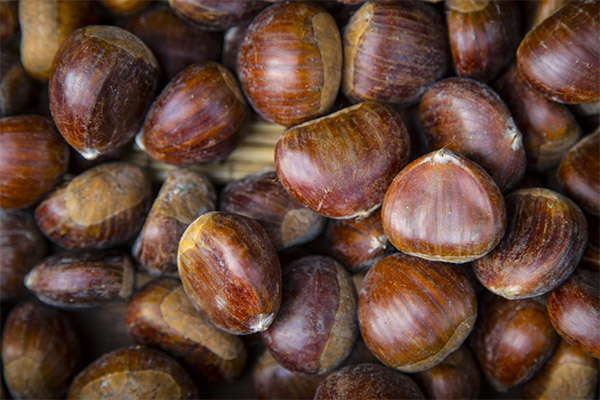
General Benefits
The chestnut fruit is like a fairy chest, where instead of diamonds is stored the most valuable and important - human health. Due to their nutrients nuts have the following properties, beneficial to the human body:
- reduction of edema;
- expectorant property;
- bactericidal effect;
- improvement of intestinal peristalsis;
- diuretic effect;
- hemostatic properties;
- prevention of atherosclerosis;
- improvement of the digestive system;
- preventing irritation of the mucous membranes of the digestive tract;
- decrease in the acidity of gastric juice;
- normalization of blood circulation;
- Prevention and treatment of varicose veins, thrombophlebitis and their consequences, as well as vascular disease;
- Improvement of general tonus of the body;
- Reduction of pain of rheumatic character;
- Normalization of the nervous system;
- Prevention of aging processes.
All this is a general effect on the body, which does not depend on the gender of the person. Meanwhile, the use of nuts can have completely different effects on the body of men, children and women.
For Women
Women simply need to include edible chestnuts in their diet. They will help to replenish the lack of useful vitamins and minerals, improve the overall condition, reduce the effects of stress. In addition, the miraculous effect of a unique product for the female body lies in the fact that chestnuts improve blood flow in the pelvic organs. This normalizes the functioning of the reproductive system and reduces the risk of cancer.
Also, the fruit will be useful during the menstrual period, because it facilitates the outflow of blood, while at the same time reducing the possibility of viral infections. Chestnuts will be useful for girls who suffer from varicose veins. The product is able to maintain and restore the elasticity of blood vessels, maintain muscle tone. The skin will also say "thank you", if the diet of the weaker half of humanity will contain these nuts, because. they noticeably improve the appearance and take care of the extension of youth.
For men
For men, the use of chestnuts will help in strengthening the immune system, increasing stamina, and the general toning of the body. Also useful for those members of the stronger sex who have to lead a sedentary life, because this category is most susceptible to such a delicate but painful problem as hemorrhoids. Chestnut-based medications help reduce inflammation, reduce pain and improve circulation.
In addition, the fruit can prevent the development of prostate cancer. Therefore, men seeking to preserve and maintain their health will benefit from the consumption of this product.
Pregnancy
The state of pregnancy is a kind of stress for the female body, on which during this period the load increases significantly. Chestnut could be an excellent additional source of vitamins, as well as to protect pregnant women from stress and nervous overexcitement.
But experts warn about the impossibility to consume the fruit while waiting for the baby. First of all, this is due to the nut's ability to affect blood circulation, which can be dangerous for the expectant mother and her baby. In addition, chestnut can cause allergies in the baby. Therefore, doctors forbid not only to consume chestnuts, but even to use them externally or as part of various medicines.
When breastfeeding
During the lactation period, breastfeeding mothers are shown a strict diet aimed at the proper formation of the infant's body. Products consumed by a woman during this period, should carry the absolute benefit and not cause the risk of developing any diseases or disorders in the baby. In this regard, the use of chestnuts during breastfeeding is also prohibited, as well as during pregnancy, because the fruit can cause dysfunction of the growing body, colic, bloating and allergic reactions.
For children
In children, the use of chestnuts will help cope with seasonal colds, strengthening the immune system, increase the overall tone of the body, have a positive effect on blood circulation, improve digestion and provide the child with all the necessary nutrients. But that said, pediatricians and experts on healthy eating recommend introducing a child to a healthy dish not before the age of five, because chestnuts are poorly digested and digested by the child's body. In addition, there can be failures of the liver, pancreas and kidneys.
The fruit is also quite capable of provoking bloating and making the process of defecation difficult. It is best to puree chestnuts and mix the product with potatoes, for example, and then see how they react. But before starting to use it, it is necessary to consult a specialist to prevent possible dangers.
When losing weight
Nutritionists recommend their patients to introduce dishes from chestnuts in the menu, because the fruit helps to regulate the work of the heart muscle, the nervous system, eliminate pain, relieve fatigue, remove excess fluid and replenish the vitamin balance. Nuts are full of dietary fiber and have a considerable caloric value, but it will not have a negative impact if you consume the product without exceeding the number of calories allowed per day.
In addition, the nutritional value of nuts is considered high, and to satisfy hunger it will be necessary to eat them very little. The main thing is a measure, and then the extra pounds will start to "go away", and the benefits of nuts will remain!
Application in folk medicine
Traditional medicine does not use chemical compounds to treat its patients, unlike official medicine. All of its recipes are based on the knowledge of ancestors, who were able to discover and bring to our times the secrets of nature, which is able to heal with its natural power. Chestnut has become a good "medicine" that helps to get rid of many diseases. In this case, not only the fruits themselves can be used for treatment, but also the bark and inflorescences of the tree.
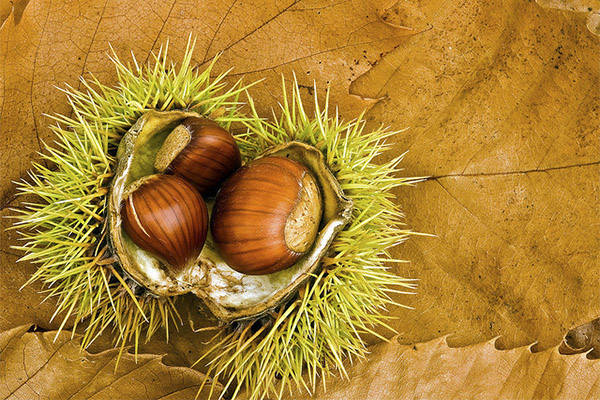
Various ointments, tinctures and decoctions help folk healers to cope with such ailments as:
- atherosclerosis;
- poor circulation;
- loss of elasticity of blood vessels;
- thrombophlebitis;
- ulcers;
- hemorrhoids;
- malaria;
- constipation;
- diarrhea;
- hemorrhage;
- inflammatory processes in the lungs.
Alternative medicine uses the following recipes for the prevention and treatment of diseases.
With varicose veins
Ingredients:
- 30 parts of chestnut flower juice;
- 1 part water.
Squeeze the juice of the chestnut inflorescence. Then mix the indicated amount of parts with water and use as an external remedy, rubbing the areas where there is inflammation.
For cyclic pains in women
Ingredients:
- water - 10 g;
- The juice of chestnut inflorescence - 30 drops.
Mix the components with each other and take twice a day.
In the treatment of thrombophlebitis
Ingredients:
- chestnut - 10 g;
- Vodka - 100 g.
Chestnuts for this recipe to crush and already after pouring them with alcohol. In this condition they must stand for 10 days in the dark. After that, filter the remedy and combine 30 drops of the drug with plain boiled water in an amount of 60 ml. Take "potion" is recommended every time before meals.
With joint pain
Ingredients:
- Chestnut - 50 g;
- Vodka - 500 ml.
Grind chestnuts at the beginning, and then add to them vodka. Put the preparation for 21 days. Take the remedy internally, drinking 20 ml before meals, and externally, rubbing the joints.
The duration of treatment should be 30 days.
With gastritis
Ingredients:
- Chestnut tree bark - ½ tbsp;
- Water - 0.4 liters.
At the first stage, combine the components and insist the remedy for eight hours. Next, boil the composition for 3 minutes from the moment of boiling, and then filter it. After that, it is recommended to divide the preparation into 4 parts and drink in one day, consuming before each meal.
For external use
Ingredients:
- chestnut - 15 g;
- Olive oil - 150 ml.
Chestnut nuts are crushed and combined with oil. Then infuse the product for 2 weeks. After that, you can rub the inflamed areas obtained oil.
For the normalization of cholesterol
Ingredients:
- 50 g of the skin of chestnut fruits;
- 500 ml of vodka.
The crushed shells combine with vodka and insist for 15 days, shaking the tincture every day. After the specified time, filter the product and then take 30 drops three times a day, mixed with the same amount of boiled water.
These simple recipes will help you to prepare the right medicines from chestnut, which can cope with many diseases no worse than medications.
How to use in cosmetology
Cosmetology, too, has not neglected the fruit of the noble chestnut. Its abilities are highly valued in disorders of capillary microcirculation and are used to improve the appearance of the skin, prolongation and preservation of youth, toning, whitening, detoxification, protection from UV radiation. It is also used as a hair-strengthening agent, as the nut is really capable of preventing hair loss by strengthening the bulbs themselves. In addition, the anti-inflammatory property has a beneficial effect on the purity of the skin, getting rid of acne and pimples.
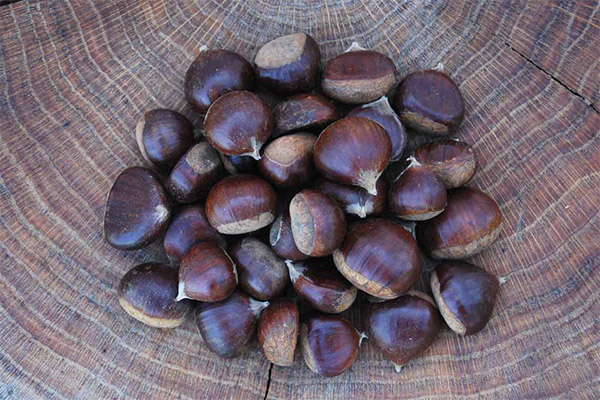
Modern cosmetic products often include in their composition the fruit or other parts of the chestnut tree. But good quality products cost a lot of money, so you can save a lot of budget and make your own magic masks and shampoos.
For narrowing pores and nourishing facial skin
Ingredients:
- chestnut fruits - 4 pcs;
- milk - 125;
- quail egg yolk - 1 pc;
- castor oil - 1 tbsp;
- Wheat flour - 1/3 tsp.
To make a mask, you must first prepare a powder of chestnut fruits, for which grind a few nuts and dry them naturally for 3 days. Then take 3 tbsp. of the obtained raw materials and add them to the boiling milk, then cover the milk-chestnut mixture with a saucer and insist for 30 minutes. Then add the rest of the ingredients, mix and apply to the face for 10 minutes. Wash after application with warm, but not hot water.
To preserve youthfulness
Ingredients:
- chestnuts;
- homemade sour cream.
To prepare this mask, boil chestnuts. The amount can be taken at your discretion. Boiled nuts to mashed potato until mashed and join them with sour cream, watching for consistency, which should resemble a mush. Then apply the composition to the skin of the face and wait 10 minutes, and then wash with cool water.
Anti acne mask
Ingredients:
- Dry powder of chestnut fruits - 2 tbsp;
- egg white - 1 pc;
- Tea tree oil - 1-2 drops.
Lightly beat the egg white with a whisk and combine with chestnut powder. Then add the remaining components and mix everything. Such a composition to keep on the face for about 20 minutes, and then wash with warm water.
Against hair loss and to activate hair growth
Ingredients: dried chestnut powder.
To stop hair loss and become strong and long, you just need to wash your hair with chestnut powder. To do this, the powder should simply be rubbed into wet hair at the roots. In this way, wash your hair once a week.
These simple recipes will help you to preserve the beauty for many years, without resorting to expensive procedures.
Edible Chestnut in Cooking
Most people associate chestnuts with the city of musketeers and majestic castles - Paris. It is there that such a delicacy has become almost a calling card. The smell of roasting chestnuts on the streets of the world fashion capital can bring back all kinds of pleasant memories or dreams. But it is not only in France that chestnuts have become popular. Cooks in many countries around the world use this product to make soups, salads, side dishes, sauces or desserts. It is customary to combine nuts with meat, vegetables, and ice cream. In this case, all these gourmet dishes can be prepared in your own kitchen:
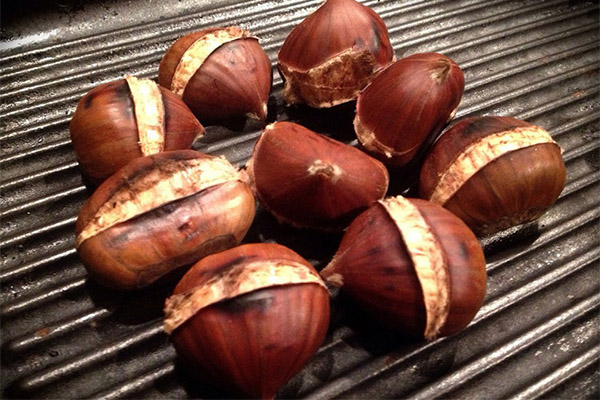
Hot appetizer "Kashtanka"
Ingredients:
- 0.4 kg of chestnut fruits;
- 0.25 kg of cherry tomatoes;
- 2 garlic cloves;
- 4-5 cm of ginger root;
- 4 tbsp. olive oil;
- salt;
- pepper.
Boil the nuts for 15 minutes, peel and cut into small pieces. Then fry them in heated oil. Next, add tomatoes cut in halves to the mass, at the same time you can pour a little liquid so that the dish will not stick. Then chop the garlic and ginger and add them to the tomato and chestnut mixture. Season with salt and pepper and simmer for 10 to 15 minutes until soft.
Baked Chestnut
Ingredients: noble chestnut fruits.
Wash the chestnuts and make a cross-shaped incision. If this is not possible, you can cut the fruit from the side. Next, place the chestnuts on a non-stick baking tray and put it in a preheated 200°C oven for 20 minutes. When the dish is ready, peel the nuts while still warm. It will be much easier this way.
Soup
Ingredients:
- 350 g of meat broth;
- 125 g chestnuts;
- 1 tbsp flour;
- 125 ml of 10% cream;
- 1 tbsp. butter;
- celery;
- Wheat breadcrumbs.
Peel the fruits and put them into a saucepan with chopped celery and meat broth. Simmer the dish for 40 minutes with the lid closed. Fry the flour in the butter and add the cream. Purée the meat stock with the chestnuts in the blender and place back on a low heat. Add the milk sauce, season with salt and pepper, bring to the boil and leave on the stove. Put croutons in a bowl with the soup.
Hazards and contraindications
Edible chestnuts can not be consumed by everyone. Unfortunately, its use is prohibited in the following diseases:
- Abnormalities of the gastrointestinal tract and its malfunction;
- bleeding in the lungs or stomach;
- Diabetes mellitus;
- predisposition to obesity;
- Pregnancy and the lactation period;
- children under 5 years of age;
- individual intolerance;
- Chronic renal insufficiency.
With such disorders and inflammatory processes, the use of nuts is not recommended by medics.
How to choose and store
To enjoy the sweetish taste of the real chestnut delicacy, it is important to make the right choice. To do this, it is necessary to follow the following rules:
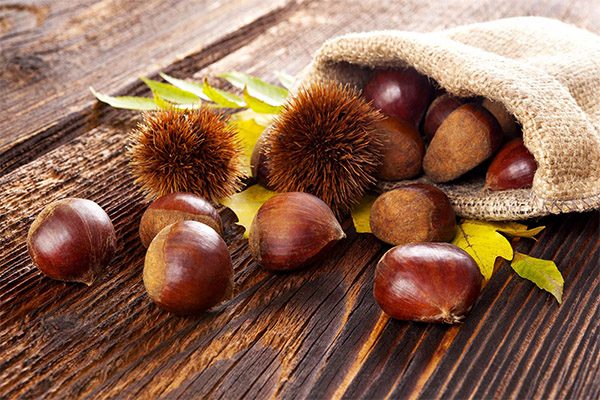
- Buy chestnuts better in the season of their fruiting, i.e. in September, October and November.
- A good chestnut should be firm to the touch, heavy, brownish-glossy in color and without any visible damage.
- The size of the nuts varies by locality and can range from the size of a walnut to an average tangerine.
- The shell of the fruit should be even and dense. If it is squeezed or has some spots, you should not buy such a chestnut.
The rules are simple and quite uncomplicated, but they are very helpful to get a real tasty product, which can have a beneficial effect on human health. But it is equally important to properly preserve the product. Chestnuts, due to the fact that they contain quite a lot of liquid, can be stored in the refrigerator for 5 days, no more. If stored in the freezer, their shelf life can be extended up to six months. You can also dry the fruits naturally or with an electric dryer. In this way they are less useful but can be kept longer in canvas bags.
Is it safe to eat horse chestnut?
Horse chestnut, of course, is similar to the noble variety, but it is forbidden to eat it. Eating these fruits can seriously poison you and get the risk of gastrointestinal disorders. But for feeding livestock this nut can be used. Also horse chestnut is well suited for medical purposes, because it is its fruits, bark and leaves serve as the main raw material for drugs, which include a mention of this product.
Interesting Facts
Chestnut - a tree is quite ancient, and therefore about it during its existence has accumulated a lot of interesting facts:
- In Geneva, a chestnut tree grows under the windows of the government. The moment the first leaf appears on it, the city government announces the arrival of spring. The paradox is that spring can come in December or March or twice in one year.
- The oldest chestnut grows in Sicily. Its trunk is 57.9 m in diameter and it is about 4000 years old.
- The chestnut fruit is considered to be the only nut that contains ascorbic acid.
- European kings, or rather the architects of castles, established an interesting pattern: spiders avoid chestnuts and do not weave their nets there. That is why chestnuts served as the raw material for the construction of many European residences.
- The most "greedy" to chestnuts are considered the inhabitants of China, because it is they who use a little less than half of all the fruits on the planet.
- In Corsican churches it is customary to consecrate chestnuts, not cakes, during Easter services.
Such a surprisingly useful and tasty nut hides in the prickly purse of an ancient tree. Chestnut has unique nutrients that can take care of human health, and therefore it is worthy to take, if not the main, then a rather honorable place among the dishes of the daily diet.
«Important: All information on this site is provided solely for introductory purposes only. Before applying any recommendations, consult a health care professional. specialist. Neither the editors nor the authors shall be liable for any possible harm caused by materials."

